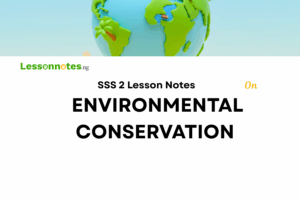Bush Fallowing in West Africa SS3 Geography Lesson Note
Download Lesson Note
Lesson Notes
Topic: Bush Fallowing in West Africa
SPECIFIC OBJECTIVES: At the end of the lesson, pupils should be able to
- Effectively carry out bush fallowing
- Explain bush fallowing and the farmable conditions necessary for it
- State the characteristics of bush following
- Describe the types and tools used
- Examine advantages and disadvantages and current trends in bush fallowing
INSTRUCTIONAL TECHNIQUES:
- Identification,
- explanation,
- questions and answers,
- demonstration,
- videos from the source
INSTRUCTIONAL MATERIALS:
- Videos,
- loudspeaker,
- textbook,
- pictures
NOTE
BUSH FALLOWING IN WEST AFRICA
Bush fallowing is an agricultural practice where a piece of land is cleared of vegetation and cultivated for a certain period and then left fallow (uncultivated) to allow the natural vegetation to regenerate before being cultivated again.
Characteristics of Bush Fallowing
- Bush fallowing involves a cycle of cultivation and fallow periods. After a period of cultivation, the land is left fallow to recover its fertility and natural vegetation.
- Fallowing allows the soil to regenerate nutrients and regain fertility. Natural vegetation contributes organic matter, prevents erosion, and helps improve soil structure.
- Farmers typically rotate the fields they cultivate and allow them to fallow. This rotation helps prevent soil degradation and maintains a sustainable agricultural system.
- During cultivation periods, a variety of crops may be planted. The diversity of crops helps reduce pest and disease pressures and contributes to a more resilient farming system.
- The Bush fallowing relies on natural processes for soil restoration. Rain, sunlight, and natural vegetation play crucial roles in rejuvenating the soil during fallow periods.
Farmable Conditions Necessary for Bush Fallowing
- Sufficient Land Availability: Bush fallowing requires sufficient land to implement the rotational cycle effectively.
- Suitable Climate: The climate should support the regeneration of natural vegetation during the fallow period. Sufficient rainfall and temperature conditions are essential for successful bush-fallowing.
- Understanding of Soil Fertility: Farmers engaging in bush fallowing should have an understanding of soil fertility and the need for fallow periods to maintain or improve soil productivity.
- Community Cooperation: In areas where land is communally owned, community cooperation is essential for effective bush-fallowing.
Types of Bush Fallowing
- Short Fallowing: Involves a relatively brief period of leaving the land uncultivated before it is cultivated again. This may be a few months to a couple of years.
- Long Fallowing: Involves longer periods of leaving the land fallow, sometimes for several years. This allows for more extensive natural regeneration of vegetation and soil recovery.
- Shifting Cultivation: Farmers move to new plots of land for cultivation while allowing previously used lands to fallow and regenerate. This is a form of rotational bush fallowing.
Tools Used in Bush Fallowing
- Cutlasses/Machetes: Used for cutting down vegetation during the clearing phase.
- Hoes: Essential for digging and preparing the soil for cultivation.
- Fire: Controlled burning is often used to clear vegetation and prepare the land for planting.
Advantages of Bush Fallowing
- Fallowing allows the soil to recover, replenishing nutrients and improving fertility, leading to better crop yields.
- The cycle of fallowing encourages biodiversity, as natural vegetation returns and supports various plant and animal species.
- Natural vegetation during fallow periods helps in water retention, reducing soil erosion and maintaining water quality.
- The diversity of crops during cultivation disrupts pest and disease cycles, reducing the need for chemical inputs.
Disadvantages of Bush Fallowing
- Increasing population and land scarcity can lead to shorter fallow periods, impacting the effectiveness of the practice.
- In some cases, extensive clearing for fallow can contribute to deforestation and loss of biodiversity.
- Unpredictable climate patterns can affect the success of fallow periods and cultivation cycles.
- Bush fallowing may not align with the demands of modern agricultural markets, limiting income opportunities for farmers.
Current trends in bush fallowing
- The practice of mechanised agriculture has discouraged bush-fallowing
- The population of the world is increasing rapidly thus putting a reduction on the size of farmland.
- There is no intensive use of fertilisers and manures.
EVALUATION:
- What is Bush fallowing?
- Identify 4 farmable conditions necessary for bush fallowing
- Mention 3 advantages and 3 disadvantages of bush fallowing.
- Discuss the types of bush fallowing
CLASSWORK: As in evaluation
CONCLUSION: The teacher commends the students positively





















